Stachytarpheta jamaicensis Vahl. |
| |
|
|
Botanical Name |
: |
Stachytarpheta jamaicensis Vahl. |
English
Name |
: |
Brazilian tea, Bastard Vervain |
Synonym(s) |
: |
Stachytarpheta indica C. B. Clarke , Stachytarpheta urticifolia Sims, Verbena cayennensis, Verbena jamaicensis |
Family |
: |
Verbenaceae |
| |
General Info
| Description |
 |
|
An erect, glabrous, annual or perennial herb, up to 180 cm high. Leaves oblong-elliptic, serrate, acute or obtuse, 2-10 cm x1.25-6.0 cm, glabrous; flowers blue, blue-purple or purple, rarely white, in terminal spikes, 7.5-50.0 cm x 0.4 cm; capsules pear-shaped; seeds black, flattened. |
| Herb Effects |
 |
|
Antiinflammtory, antihistamine, bronchodilator, antacid, antiparasitic, stimulates the central nervous system, abortifacient and hypothermic (plant). |
Chemistry
| Active Ingredients |
 |
|
Stigmasterol, friedelin, hispidulin, ursolic acid, choline, scutellarein and phenolic acids (leaf); apigenol-7-glucuronide, alpha-spinasterol, gamma-amino butyric acid, chlorogenic acid, citral, dopamine, friedelin, geraniol, hentriacontane, hispidulin, ipolamiide, luteolol-7-glucuronide, n-dotriacontane, n-nonacosane, n-pentriacontane, n-tetratriancontane, n-triacontane, n-tritriacontane, salicylic-acid, scutellarein, stachytarphine, stigmasterol, tarphetalin, ursolic acid, and verbascoside (plant). |
| Chemistry
of Active Ingredients |
 |
|
|
 |
Name |
CAS# |
IUPAC Name |
Formula |
Structure |
 |
|
| Stigmasterol |
4736-55-4 |
17-(4-ethyl-1,5-dime
thyl-hex-2-enyl)-10,
13-dimethyl-1,2,4,5,
6,7,8,9,10
,11,12,1
3,14,15,16,17-hexade
cahydrocyclopenta[a]
phenanthren-3-one |
C29H48O |
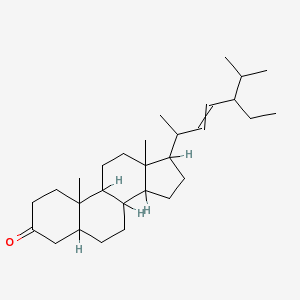
|
| Friedelin |
559-74-0 |
4,4a,6a,6b,8a,11,11,
14a-octamethyl-2,4,5
,6,6a,7,8,9,10,12,12
a,13,14,14
b-tetrad
ecahydro-1H-picen-3-
one |
C30H50O |
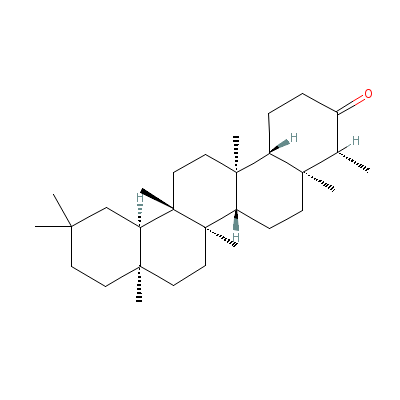
|
| Hispidulin |
1447-88-7 |
4,5-dihydroxy-2-(4-h
ydroxyphenyl)-6-meth
oxy-chromen-7-one |
C16H12O6 |
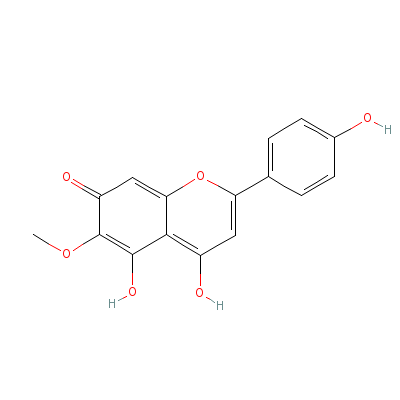
|
| Ursolic acid |
77-52-1 |
10-hydroxy-1,2,6a,6b
,9,9,12a-heptamethyl
-2,3,4,5,6,6a,7,8,8a
,10,11,12, |
C30H48O3 |
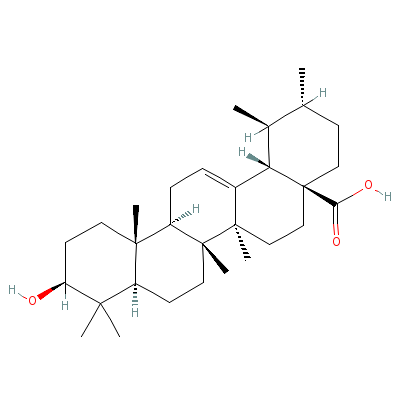
|
| Choline |
67-48-1 |
2-hydroxyethyl-trime
thyl-ammonium |
C5H14NO+ |
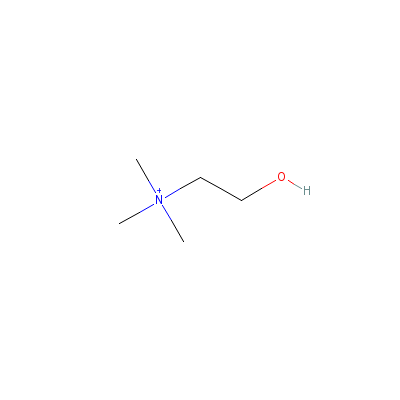
|
| Scutellarein |
Not Available |
5,6,7-trihydroxy-2-(
4-hydroxyphenyl)chro
men-4-one |
C15H10O6 |

|
| alpha-Spinasterol |
481-18-5 |
17-(5-ethyl-6-methyl
-hept-3-en-2-yl)-10,
13-dimethyl-2,3,4,5,
6,9,11,12,
14,15,16
,17-dodecahydro-1H-c
yclopenta[a]phenanth
ren-3-ol |
C29H48O |
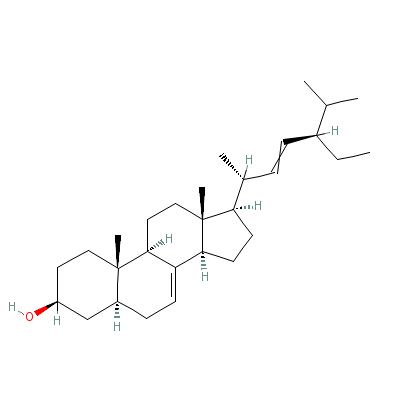
|
| Chlorogenic acid |
327-97-9 |
3-[3-(3,4-dihydroxyp
henyl)prop-2-enoylox
y]-1,4,5-trihydroxy-
cyclohexan
e-1-carb
oxylic acid |
C16H18O9 |
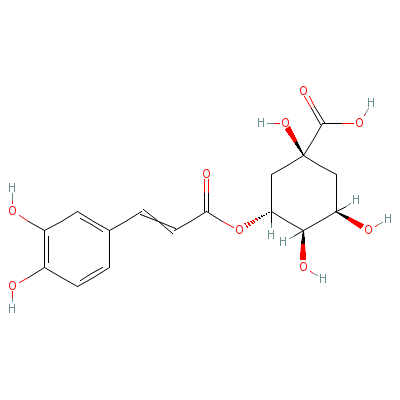
|
| Citral |
96680-15-8 |
3,7-dimethylocta-2,6
-dienal |
C10H16O |

|
| Dopamine |
62-31-7 |
4-(2-aminoethyl)benz
ene-1,2-diol |
C8H11NO2 |

|
| Geraniol |
8007-13-4 |
3,7-dimethylocta-2,6
-dien-1-ol |
C10H18O |
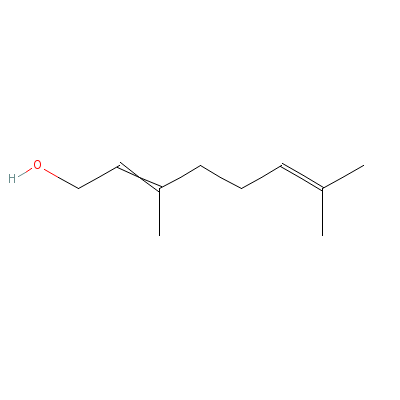
|
| Hentriacontane |
630-04-6 |
Hentriacontane |
C31H64 |

|
| Hispidulin |
1447-88-7 |
4,5-dihydroxy-2-(4-h
ydroxyphenyl)-6-meth
oxy-chromen-7-one |
C16H12O6 |

|
| Ipolamiide |
Not Available |
methyl
(1S,5R,6S,7R)-1,7-di
hydroxy-7-methyl-5-[
(2S,3R,4S,5S,6R)-3,4
,5-
trihydroxy-6-(h
ydroxymethyl)oxan-2-
yl]oxy-4-oxabicyclo[
4.3.0]non-2-ene
-2-
carboxylate |
C17H26O11 |

|
| n-Dotriacontane |
544-85-4 |
dotriacontane |
C32H66 |

|
| n-Triacontane |
638-68-6 |
triacontane |
C30H62 |
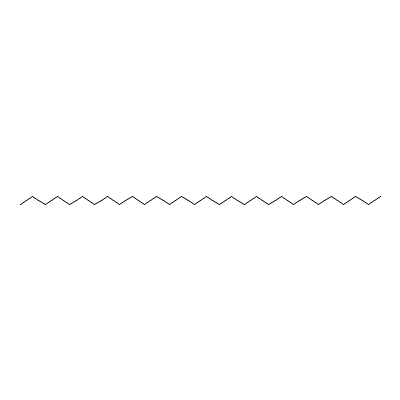
|
| n-Tritriacontane |
630-05-7 |
tritriacontane |
C33H68 |

|
| Salicylic acid |
8052-31-1 |
2-hydroxybenzoic
acid |
C7H6O3 |
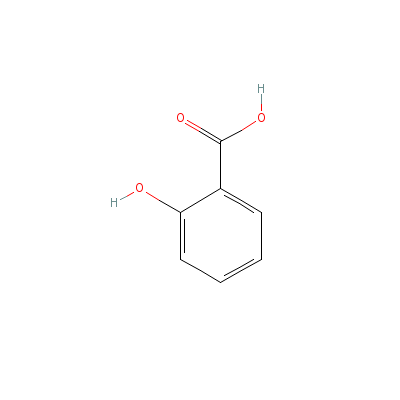
|
| Scutellarein |
Not Available |
5,6,7-trihydroxy-2-(
4-hydroxyphenyl)chro
men-4-one |
C15H10O6 |

|
| Stigmasterol |
4736-55-4 |
17-(4-ethyl-1,5-dime
thyl-hex-2-enyl)-10,
13-dimethyl-1,2,4,5,
6,7,8,9,10
,11,12,1
3,14,15,16,17-hexade
cahydrocyclopenta[a]
phenanthren-3-one |
C29H48O |

|
| Verbascoside |
Not Available |
[(2R,3R,4S,5R,6R)-6-
[2-(3,4-dihydroxyphe
nyl)ethoxy]-5-hydrox
y-2-(hydro
xymethyl
)-4-[(2S,3R,4R,5S,6S
)-3,4,5-trihydroxy-6
-methyl-oxan-2-yl]ox
y-
oxan-3-yl]
(E)-3-(3,4-dihydroxy
phenyl)prop-2-enoate |
C29H36O15 |

|
|
Pharmacology
| Medicinal Use |
 |
|
As an antiinflammatory and reducing fever, for treating intestinal worms, venereal diseases, erysipelas, dropsy, asthma, bronchitis, rheumatism and stomach ailments (indigestion, acid reflux, ulcers, constipation, dyspepsia, slow digestion) (plant); for cataract and open sores (plant juice); for colds and cough, in cardiac troubles and are also rubbed on sprains and bruises or used as cataplasm for boils (leaves); applied topically to treat dysentery (Paste of stem and root bark) |
| Contraindication |
 |
|
Avoid use when pregnant, if allergic to aspirin or have a heart condition. |
| Reference |
 |
|
 Chandel et al., Biodiversity in Medicinal and Aromatic Plants in India. Chandel et al., Biodiversity in Medicinal and Aromatic Plants in India.
|
Dealers
Products
|
|